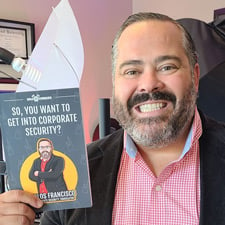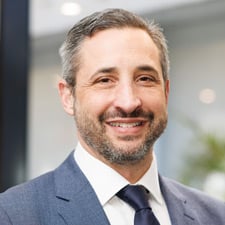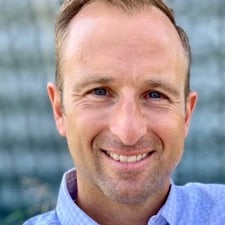The landscape for corporate physical security continues to evolve at a rapid pace. And over the past few years, companies struggled to adapt to a swath of different challenges – from a pandemic and hybrid offices to a war in Ukraine and disrupted supply chains.
But what’s coming next?
To get some insight, we asked 21 corporate physical security experts what we could expect in 2023 and beyond. In this article, you will learn what risks you should watch out for, what trends will shape the marketplace, and what opportunities you can exploit to your advantage.
The only constant in our industry is change. So let’s dive into the predictions!
21 Corporate Security Predictions for 2023
1. Mike Evans – Securitas UK
Every year, organizations publish reports forecasting the year ahead, including surveys based on responses from experts and practitioners. The World Economic Forum (WEF) Global Risks report in 2022, highlighted that respondents’ concerns were dominated by environmental risks when asked ‘Identify the most severe risks on a global scale over the next 10 years. Geopolitics was largely overlooked. However, the responses were collected on the coattails of COP26, and the many natural disasters and severe weather events of 2021. Similarly, the 2021 report highlighted health and infectious disease risks, following the responses in 2020, when COVID-19 was still ‘new’.
The 2023 report (based on responses collected in 2022) will likely be dominated by geopolitics.
Ultimately this indicates an increased sensitivity towards proximate risks, an acceptance/tolerance of risk that are not as ‘noisy’ in the current climate (pun not intended), or a potential blindspot in identifying and assessing emerging risks. But where there is risk, there is opportunity. And that is where intelligence comes in.
 |
Mike Evans |
2. Denida Zinxhiria Grow – Athena Worldwide
One of the most challenging and tedious tasks, I believe, that is facing physical security in 2023 is the overall process and mindset encompassing Travel Risk management. COVID has made travel an entirely different arena and as the globe continues to open slowly to travelers, all the rules and regulations are shifting and evolving. Advances require new sets of pre-planning details, some C-Suite personnel are requesting significant alterations to what once seemed an effortless planning process and some countries around the world still hold extremely strict rules for outside travelers entering their prospective spaces.
The close protection agent, carefully and thoroughly, must play an intricate thinking game to prepare for these new changes and be ever mindful of both the needs of his/her client as they pertain to and interact with the requirements that travel has placed upon them.
 |
Denida Zinxhiria Grow |
3. Neil Spencer – LifeRaft
The knock-on effects of the COVID pandemic compounded by Russia/Ukraine will lead to
continued supply chain and financial challenges on a global scale. The resulting macroeconomic impacts will drive recessions in developed countries and food insecurity within developing nations.
Historic trends show that recessions lead to increases in social unrest and crime. As a result, human-driven events that cause business disruption may increase, and businesses should identify approaches to mitigate any impact.
Recession will drive the tightening of belts across all departments within an enterprise. This has already been seen, with Tech being a bell-weather industry. However, as with the COVID pandemic, this will provide Security Teams another opportunity to show value to the business by being both an early warning system for possible business disruption as well as identifying trends that may impact strategic activities.
The social media landscape will continue to fragment as the impacts of Elon Musk's Twitter acquisition are realized. A subset of users will migrate to a growing set of alternative social media platforms such as Mastodon, Hive, Post, and Truth Social. However, changes in Twitter's moderation policies may also see the return of more extreme chatter.
 |
Neil Spencer |
4. Suzanna Alsayed – Evolutz Inc.
Social media and cyber monitoring represent one of the biggest opportunities for corporate physical security professionals in 2023. Our world is now digital. There is no avoiding it, at this point if we are not online, we are considered “not legitimate”. For instance, there is this hypothetical mentality that if it wasn’t posted, it never happened. 2023 will be the year of social media, where everyone will seek out marketing and branding reinforcement to stay up-to-date and on-trend. However, with an active online presence, there will also be more exposure to cyber risks. Hence, professionals and companies will have to find ways to balance both, content and cyber awareness.
 |
Suzanna Alsayed |
5. Mark Folmer – Robotic Assistance Devices
The current economic uncertainty will drive security professionals to further challenge the status quo as they are forced to show value. In other words, while security in general (and my primary focus, security services), may be recession-proof, that does not hold true in its current state. The shortage of frontline staff, hourly rate increases, and increased risks are not disappearing. Many questions will be asked of security professionals, including, can savings be had? Can more be done with less? What is the return on our security posture? Is there another way, without increasing risk? How can we communicate value to the organization’s mission?
As an industry, we will be further tasked to deliver more with less and look to things like AI-powered autonomous remote devices, on-demand security, remote services, workforce-enabling tools, and accessible data all the while showing a positive return. The ability to communicate ideas and show value will be the norm. The limits of our comfort zone will be challenged, and the uncertainty will force us to find the time and develop the appetite to accept change.
Is it time for flying cars? Not yet, but disruption will lead the way in 2023!
 |
Mark Folmer, CPP, FSyI |
6. Mike Hurst – HJA Consult
Physical and digital security has over the last few years been drawing closer, with phrases with blended security and converged security becoming everyday terms. ASIS International has, for some time, been championing Enterprise Security Risk Management (ESRM) and has just published its latest ESRM Maturity Model. I feel that we are getting closer to having security that aligns fully with the needs of an enterprise and is a true enabler and not a blocker.
Slightly worrying though, is the recent SRI research from Perpetuity. This highlights, the fact that security professionals often don’t have enough influence over security procurement. It does, however, offer some suggestions.
 |
Mike Hurst, CPP, CPOI, MSyI, FREC |
7. Scot Walker – Walker & Associates LLC
The biggest risk in 2023 won't be climate change, civil unrest, Russia, North Korea, or alien invasions (well, maybe that). The biggest risk in 2023 will be from us, maybe not you and I specifically, but from our family, friends, and neighbors who will be turning 65 years old. According to the US Census, approximately 10,000 people will turn 65 every day until 2030. That means they will have access to more affordable healthcare / social security and will likely leave the workforce.
For the global security industry, that means security staff who control access to your facility and answer calls in a GSOC will be rare. I know business leaders like Elon Musk are bullish on artificial intelligence to replace human-centered roles, but that costs money. And, in a contracting economy, that means less money for a security budget. Therefore, it is our challenge to invent new ways to solve age-old security problems, this time with less money, more risk, and fewer people. Who's up for the challenge?
 |
Scot Walker |
8. Yariv Lis – Verensics
Since COVID came into our lives, we are exposed to a growing number of employee misconduct and workplace crime. Unfortunately, I see that as one of 2023's main challenges, working remotely and short-staff creates an opportunity—and people are opportunistic by nature.
For some people, opportunity is when no one is watching or when they identify loopholes in the system, and it has nothing to do with higher education or senior titles. This is why we have white-collar prisons; these facilities are built for well-paid and well-educated employees that made a bad choice. I believe that for 2023, people and companies are going to realize that security risks are reduced in the long run by better screening on the front end.
 |
Yariv Lis |
9. Will Plummer – RaySecur
In 2022, we saw a rise in mail threats targeting all types of organizations and using new and inventive methods. A significant contributor to these threats is the frustrations felt with today's society—the constant presence in our lives through the broadcast media and social channels. At some point, people react in potentially violent and threatening ways. Organizations and high-profile individuals become the targets as they are viewed as the source of wrongs.
We expect the trend to continue in 2023 with an increase in frequency and a broader target base as people learn of successful threat events and copycat incidents. Softer targets will be forced to mitigate threats historically tied to large companies with security forces and individuals surrounded by executive protection teams.
 |
Will Plummer |
10. Alan Saquella – Embry–Riddle Aeronautical University
At Embry–Riddle Aeronautical University, we have a long history of training students how to become pilots. But nowadays, we’re also training them to operate drones. And that’s a huge future in corporate physical security – using unmanned drones to do surveillance.
At a previous company where I was the Director of Corporate Security, we owned large pieces of property where we may be running fiber lines or storing equipment. You couldn’t have a camera on the fence line. The area you needed to protect was just too big.
To get around this problem, we started using drones with talk-down capabilities. It was exciting! You'd dispatch the drone and you’re talking. You’re having a conversation with the culprit who has just breached the fence. You’re videotape recording them. You’re talking to them. And you’re telling him to leave the premises.
Across the country, we have a labor shortage. So what do you do? The best corporate physical security teams have totally embraced technology to help them. You’re going to need tools that can supplement those personnel shortages.
It’s not going to replace people because you can’t even fill those voids. But you need to find ways to protect your organization which is also safe and makes the public feel comfortable. Security technology, like drones, CCTV, and social media monitoring, is the future for protecting assets and people.
 |
Alan Saquella, CPP |
11. Rob Holmes – MI33
The greatest threat we are seeing is the exponential growth in physical threats being made online. We all know by now that much of the violence we see perpetrated had been projected on social media. Due to the massive amount of data on the Web, reporting has not yet been mastered. We have seen police charge children with terrorism over tweets, and we have seen murderers showing obvious signs in advance of their horrific acts.
In 2023, I predict that there will be a gold rush to systematize the response system. AI will not be enough since taking down projections will only assist in abetting attacks. Investigative teams must focus on qualifying threats as they come up, and building a clearing house for prevention by intervention.
 |
Rob Holmes |
12. Carlos Francisco – Corporate Security Translator Podcast
The budget cuts and layoffs that occurred through the second half of 2022 will allow us to make more risk-based decisions.
For the past few years, companies have thrown too much money into lowering risks portrayed in Hollywood that rarely happen in reality. Security leaders have worried about a Spiderman threat agent entering your workplace. Or a real-life 007 planting a 1960s Batman-style booby trap.
Risk acceptance will grow by companies understanding and educating themselves that the potential loss from said risk is not enough to warrant spending loads of money to avoid it.
The risk tolerance attached to risk avoidance will become in everyone’s mind as companies will be willing to take on less risk and become more conservative, and more risk will be transferred to others or insurance companies. After all, why pay $250,000 a year to protect $100,000 of merchandise if my insurance covers up to $1 million?
The talk of risk in 2023 will become more intelligent and focused on the true risk. Not some cartoonish story told on TV.
 |
Carlos Francisco, CPP |
13. Chuck Harold – SecurityGuyTV.com
We might not realize it yet but the re-platforming of Twitter is one of the most significant events of the last century.
Twitter has quickly moved towards an open, free-speech platform, the antithesis of the previous business model.
The lifting of previous Twitter restrictions will result in the release of previously suppressed information, the collision of opposing belief systems, and great public debate.
Honest public debate results in the truth seeping its way into the collective consciousness.
In 2023, the truth about many things will emerge through Twitter. This will leave many in society worldwide, disenfranchised with their leaders, governments, and public institutions.
In 2023 security practitioners can expect the collapse of strongly held beliefs, worldwide public protests, the disruption of governments, interference with institutions, and a second interruption of the worldwide supply chain.
As the German Philosopher Arthur Schopenhauer (1788 to 1860) once said;
"All truth passes through three stages. First, it is ridiculed. Second, it is violently opposed. Third, it is accepted as being self-evident."
The world is currently in the second stage of truth.
|
|
Chuck Harold |
14. Rick Mounfield – Optimal Risk Group
I sees three major risks, trends, and opportunities playing out in 2023:
- Groupthink represents the biggest risk/threat. The corporate physical security industry is full of second-career military and police (I am one of those) and therefore we form teams to address emerging threats and very quickly find a solution based on our own biases and experience. Without diversity of thought, we are not maximizing potential to find innovative solutions. We see the same threats and in the world of security, threats are diverse.
- The trend that worries me most is that cybersecurity is not approaching convergence with the same appreciation that protective security does. Physical and personnel security considerations are equally as important as patching vulnerabilities because people commit crimes and people prevent crimes. Everything else is a tool. Physical access to IT systems is often an easier attack method than penetrating the system digitally.
- Opportunity: As we are in the fourth industrial revolution, connectivity is the keyword in the 3rd Generation of CPTED and smart cities as much as it is in cyberspace. But connectivity relates to communities too. The protect duty will rely on information sharing and digital connectivity offers a variety of tools to collect data and identify threats to publicly accessible spaces to combat terrorism.
 |
Rick Mounfield, MSc, CSyP, FSyI |
15. Matthew Porcelli – Harvard Protection Services, LLC.
Opportunities and trends for physical security countermeasures in the year 2023, and well into the mid-2020s, will be abundant and full of exploratory objectives in keeping people and property safe.
As COVID-19, now classified as an “endemic,” substantiates the effectiveness of a hybrid work culture, this will continue to allow not only an increase in cyber threats but also physical threats from criminal mischief to organizational facilities. What links cyber and tangible threats together is based on the amount of opportunity for aggressors to leverage, which is why it is up to organizations to limit the amount of time the window of opportunity is open and just how secure the security framework of that “window” is.
When discussing physical security threats, security practitioners, regardless of where on the hierarchy they sit, (Contract Security Officer, Chief Security Officer), must continue to make their security departments understand that the aggressors are not mindless hackers or delinquents. These individuals often time will spend months or even years perfecting their approach to penetrate an organization’s physical security infrastructure.
Yes, opportunity is bountiful for security service providers and vendors in partnering with organizations to harden their security structure in 2023. The response, however, cannot be reactive. Physical security countermeasures must continue to remain proactive through training, audits, and exercises; making it harder for aggressors to reach their unethical objectives.
 |
Matthew Porcelli, MSc, CPP, F.ISRM, MSyl |
16. Russ Law – Verensics
Workplace investigations are increasing in frequency and complexity. The people inside corporations tasked with those investigations – whether Loss Prevention, Human Resources, or Corporate Security – are having to triage cases, and Boards don’t like the damage that does to company culture and morale. The overriding challenge is that these groups are traditionally under-resourced and overworked.
Therefore, I believe that these professionals are going to start looking to new technology to help, and technological solutions are becoming available to meet this need where there were extremely limited and archaic solutions before. 2023 will be an exciting time to work in this space.
 |
Russ Law |
17. Chris Grow – LeMareschal LLC
I truly believe there are two aspects that will have an equal and resounding effect on EP and close protection in 2023. Although many challenges always exist, these two are becoming more prevalent.
First, the entire subject of Intel Analysis/Protective Intel being on point and relevant to the actual teams on the ground. As we've discussed before, these highly qualified individuals are in a position to be our eyes and ears on the ground in ways we can't be. However, if the information they are passing forward is irrelevant or useless to the team, then they're merely treading water and really getting nowhere and are not assisting the team properly. Communication between the team and the Protective Analysis groups is critical. Knowledge of what the mobile team actually needs is incredibly useful. Providing an outline of what will be required or necessary will be helpful. Cooperation and communication will always be key.
The second point will be the advance work and mobile team movements throughout the world due to COVID restrictions, changes or regulation implementations. Advances now require a whole new template for pre-planning and the corporate groups are requesting changes/alterations to their normal travel procedures, and countries have adopted new rules if traveling in their respective spaces. The professional EP agent will need to be thinking one step ahead of these new changes and be ever mindful of their clients requests or needs as they travel and become mobile again as this "opening up" progresses all around the world.
 |
Chris Grow |
18. Dr. Gavriel Schneider – Risk 2 Solution Group
Dr. Gavriel Schneider sees three major risks, trends, and opportunities playing out in 2023:
- Cross-Skilling/Up-Skilling/Multi-Skilling. Many security practitioners have had to develop new skills and broadened their capabilities to include aspects such as holistic incident management, crisis response, conducting business resilience, and continuity activities. This trend should be something that the security sector continues to expand into, with significant opportunities available for all players in the industry to develop their skill sets. With a specific focus on physical security, this means that we cannot afford to look one-dimensionally at psychical security as a stand-alone
- Convergence and integration. In many ways. the security industry has evolved to be highly specialized and siloed. There is an opportunity to integrate specialties across the ‘Whole of Person Model’, which includes work, personal and virtual aspects. We already see many signs of convergence (i.e. cybersecurity integrating with conventional offerings such as electronic and protective security). To continue this trend, physical security practitioners should be encouraged to grow their cyber security skills and vice versa.
- Increased dependency on experts and extended stagnation. Most managers and leaders have experienced significant decision/leadership fatigue from managing continuous disruption. As a result of this fatigue, it is likely they will lean on experts more in 2022 and 2023. It would be smart for security experts to ensure they have positioned themselves as trusted advisors based on this trend. Conversely, the stagnation that many sectors have had to endure, where leaders and managers have been frozen/paralyzed, unable (or perhaps unwilling), to make decisions, may continue into the second half of 2022, but realistically couldn’t continue much longer without severe economic repercussions.
 |
Dr. Gavriel Schneider |
19. Peter Backman – Tedcap
The integration of digital and physical realities is a major potential risk scenario for organizations and nation-states. This trend became exacerbated during the pandemic due to the accelerated digital transformation that occurred, made worse by the lack of legislation around the ethical use of Artificial Intelligence. Given the size, nature, and complexity of the market, there is a need for an integrated security strategy which most organizations do not have the know-how or the resources to tackle.
Environment risks with the potential for geopolitical disruption pose a major risk to corporate communities and citizens worldwide. Droughts, hurricanes, earthquakes, and food insecurity have proven to be key factors that accelerate conflict and unstable global market conditions. To move our societies forward, it is necessary to incorporate: risk management, adaptation to climate change, and sustainable development.
 |
Peter Backman, CSyP, AMBCI |
20. Rick Musson – Clearsurance
Rick Musson sees three major risks, trends, and opportunities playing out in 2023:
- Violent crime will increase in 2023, putting physical security at a greater risk. While crime in many major cities was down in 2022 compared to the two previous years, it has been higher than before 2020. Many crimes are becoming unpunishable in some cities and states, and drug use is increasing, leading to more associated violent crimes.
- Home invasions and burglaries are one of the biggest physical security threats to watch out for in 2023. Another significant risk in 2023 will be criminals taking advantage of people in places of vulnerability. For example, when someone fills their car with fuel, they should watch out for robbers.
- More people are protecting their physical security by arming themselves. Retailers have a hard time maintaining supply to keep up with demand. And the more gun control is spoken of by politicians, the more citizens stock up on firearms.
 |
Rick Musson |
21. Susan Cho – Hyperion Service
For corporations and governments, we are going to see an even greater spike in threats and attacks from criminal groups and hostile nation-states against critical infrastructure (i.e. oil & gas and power generation facilities, pipelines, data centers, etc.), worker strikes, and widespread social/economic protests. For the private individual, there will be a much bigger increase in theft and - for those who travel outside of the US - a much greater increase in kidnapping-for-ransom attacks.
Internationally, we see the overall security, energy, and economic situations in Ukraine / Europe getting much worse, which will have huge security impacts to Americans in Europe as well as far outside of Europe. We're also keeping a close eye on the evolving situation in Taiwan. An invasion by China will have a far greater impact on the global economy and geopolitical landscape than what has transpired in Ukraine. Domestically, we see social and political unrest and violence increasing dramatically, exacerbated by foreign influence fanning the flames.
 |
Susan Cho |

